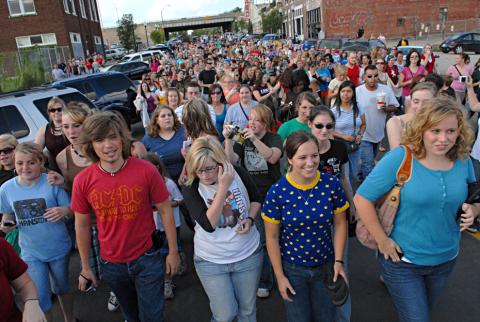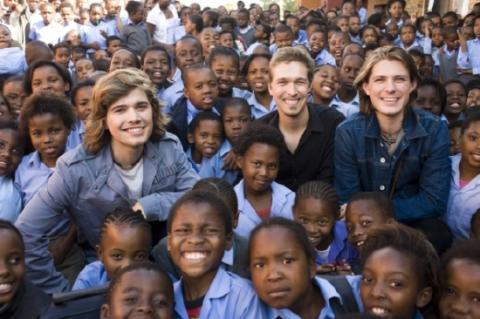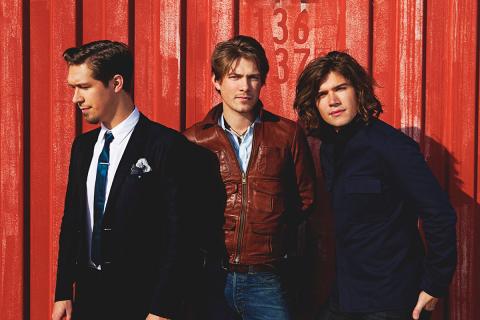
Hanson, the band of brothers best known for their 1997 smash hit, "MMMbop," have had a dedicated fan-base since those teen idol days and as they continue to sell out shows around the world are inspiring thousands to join their charitable efforts — walking, barefoot. Not everyone doffs their shoes, but that's the idea.
Isaac, now 31; Taylor, 28; and Zac, 26, spearhead Take The Walk, for which they walk barefoot for one mile before their various live shows, raising money to help alleviate poverty and AIDS in Africa. The money is then distributed to partners Free The Children, HIVSA, TOMS Shoes, Docvia and Blood Water Mission.
"We are like a fundraiser that doesn't reinvent the wheel," Taylor tells www.samaritanmag.com during a day-time interview at Toronto's Phoenix Concert Theatre where they sold out the evening performance in support of their 2011 album, Shout It Out. "We didn't create an overhead so we could be a new organization to build schools; we give directly to [other charities]."
Since starting Take The Walk in 2007, Hanson has walked close to 100,000 miles with their fans in the hot sun and chilly snow on the sidewalks and streets of North America and Europe — Toronto, Montreal, Vancouver, New York, New Orleans, Paris, and London included — braving gum, cigarette butts and more than a few unknowns.
"I've had burned feet, literally — blistered feet,” Isaac says.
“We stepped on glass a few times, and hot hot hot hot cement,” adds Taylor.
Of course, this little discomfort is nothing compared to what many adults and children in African endure on a daily basis, so you won’t hear any complaining from the Hanson boys.
“It’s this idea of humbling yourself enough to walk barefoot,” says Taylor. “For us, barefoot is a metaphor — it's not just without shoes; it’s a metaphor for poverty."
On Hanson’s web site, in the “activism” section, or directly at www.takethewalk.net, there is all kinds of information on the causes, as well as how to register to host and organize your own a walk. No the brothers don’t show up, but they will donate $1 for the first mile walked. The “Find A Walk” section shows hosted walks and Hanson walks.
Everyone from friends to sports teams to classrooms and church groups to entire neighbourhoods — from five people to 1500 — have set up their own Take The Walk. You register, “jump through a few hoops to show you’re actually committed to doing it,” says Taylor, and then receive stickers, posters, and other materials to help promote it. Setting up Twitter and Facebook pages also bring in fellow walkers.
“We are not trying to say, ‘Tomorrow we are going to cure HIV or going to stop poverty,’ but what we genuinely feel is the bigger mission and our effort is how many people have done it because what happens is you have recurring giving,” says Taylor.
Walk hosts can also choose from one of the five Hanson-affiliated charities:
Free The Children was founded by Canadian Craig Kielburger and is based on the concept of children helping children; HIVSA helps people infected with or affected by HIV and AIDS in South Africa; TOMS Shoes is a retailer which donates one pair of shoes to a child in need for every pair purchased; Docvia, based in Hanson’s hometown of Tulsa, Oklahoma, provides inexpensive health access globally; and Blood Water Mission empowers communities to work together against the HIV/AIDS and water crisis in Africa.

“We've had enough people walk in the last five years to circle the globe twice. We are the sponsor of the first dollar — that is our giving component — and then we say, 'Okay, we supported your dollar. What we wanted was action. You showed up. So now, we encourage you to see how this [works] — give to water, give to shoes, give to medicine, choose your cause. At that point, people take it with them and they either become organizers or they donate more. That's how we raise money."
The impetus for Take The Walk stemmed from a trip to Africa Hanson took in 2006 at the same time they were working on songs for a new album, The Walk. They had a friend working at a hospital in Africa developing a technology (through Docvia) that could be used for health care in the developing world.
“We saw them deciding to do something that was unique, where they were giving away the technology; at the same time, we had people we respected talking to us about what was going on in Africa with HIV,” Taylor says.
"What really resonated with us was that, specifically Africa, HIV and poverty, how all this comes together,” he says of that initial trip. “You have a generational challenge. We have a world where everyone can communicate with each other. We have a lot of tangible ways to see what problems are going on in the world. HIV and poverty are for one, curable.
“It’s not like cancer, where you have generations of doctors that have been trying to figure out why people actually get cancer and how to stop it or take care of it. HIV, you know where it comes from; you know how to solve it and how it affects generations that are born with it. A lot comes out of education, and then poverty in and of itself is a huge part of what has caused that to proliferate.”
On one visit to an orphanage in Mozambique, Hanson found themselves inspired by the children's love of music. There, they recorded the kids singing "ngi ne themba," which translates to "I have hope." When they returned to America, they used that as the opening for the song “Great Divide.” The track was released as a digital single to raise money for the Perinatal HIV Research Unit in Soweto, South Africa, a hospital that helps to reduce the transmission of pre-natal HIV/AIDS.
At the same time, the brothers partnered with TOMS Shoes, which had only just launched. “We were curious about how to facilitate the message and here's this small company doing something unique — social entrepreneurship, making giving part of your branding,” Taylor explains. “We just loved their story.”
After their first walks in 2007, they went back to Africa with TOMS to participate in a shoe drop, giving 50,000 pairs to those in need.
“I think that what we saw was the reality,” continues Taylor, the most garrulous of the Hansons and very passionate about the cause.
“The solutions came down to a lot of tangible changes. You give a pair of shoes to someone so they have less chance of getting an infection and causing a downward spiral and getting ill; or clean water so that a young woman can breastfeed and not transmit HIV to her child; or get access to a very inexpensive drug that a mother would need so that she wouldn't transmit HIV to her child while she was pregnant.

“We never really liked the red carpet celebrity charity thing,” Isaac interjects.
“There is a place for going and showing your face and supporting a cause and buying a $1000 [ticket] and supporting the charity ball,” Taylor adds. “That’s a reasonable way to do it. But we wanted to talk about it in a way that might be the beginnings of something that could feel like a movement. So The Walk idea just sprang from that. We said, ‘What could we do to give the example of tangible action connecting with this cause and with our journey?’”
“And how could we lead by our actions and not by our words?” adds Isaac.
In 2008 Issac, Taylor, and Zac decided to start logging their miles walked. Four years later, the brothers and their followers have walked 87,894 miles.
The numerous fundraising walks have enabled one school to be built for 100 children; one well to be drilled; and medicine for 250 expectant mothers to help stop the likelihood of HIV being passed on to their unborn children. People can also purchase short message service (SMS) credits for Docvia, which are used to keep an open connection between a patient and doctor while they undergo treatment for HIV.
The activism has been detailed extensively in their book, Take The Walk, which documents their experiences in Africa in 2006. Proceeds from each copy sold also go to all five causes.
Taylor says they are in the process of pausing Take A Walk in order to set new goals for it. Half of the overall 88,000 miles were by walks that others coordinated, so Hanson can see how the campaign grows when they encourage others to organize their own events.
“We want a lot of the people who have been a part of it to be able to see some more examples of what they have accomplished,” he says. “Our hope is that there will be an opportunity for us to bring some of those people with us to see physically what it is that they’ve done and share that with the community and spread that message at the top-end of the generation on down.
“We need to continue to change the conversation about how we are going to face the world's problems and it’s going to come down to living by example. The fact that there are a lot of daily things that we can do to attack things that seem overwhelming, to ask harder questions, and for companies to be more transparent and non-profits to just go directly to the problem.”
Isaac jumps in at this point and brings up kiva.com, the non-profit which allows those in a more advantaged position to give business loans of as little as $25 to people in 61 different countries.
“I think it really important and it’s unique to our generation and to our time because really what you're trying to do as much as anything — you're not just trying to give charity; you're not trying to give a hand out — you're trying to give a hand up. As the old adage says, ‘you can feed a man for a day by giving him a fish, or you can feed a man for the rest of his life by teaching him to fish.’
“On some level or another, the goal needs to be sustainability of helping people to get out of poverty,” Isaac continues. “So when we visited Africa, the thing that struck me so much was the intense underpinning of desire for entrepreneurism, the desire to lift themselves from an otherwise very potentially depressing scenario. I think that we have an opportunity in the Western world to be able, maybe in a different way than ever before, to partner with our friends around the world to help them develop their own economies.
“Ultimately, that will be the solution to get people out of poverty. How do they get out of poverty? It’s not just going to be with NGOs and with non-profits and 501c3 organizations; its going to be them building their own economies and us being able to help them do that. And there are so many great opportunities to do that.”
2020 Air Jordan 1 Retro High OG "UNC Obsidian" For Girls 575441-140